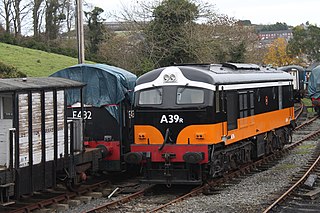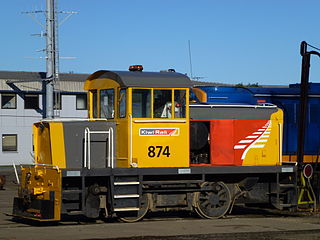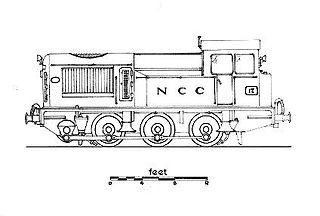Although prototype diesel locomotives ran in Britain before World War II, the railways of both the Republic and Northern Ireland changed over much more rapidly from steam to diesel traction than those in Britain, due to the island's limited coal reserves and an ageing steam locomotive fleet.
The Córas Iompair Éireann 601 Class locomotives were built in 1956-1957, by Motorenfabrik Deutz at Cologne, Germany. They were 3 small shunting locomotives of B wheel arrangement and were fitted with a Deutz V8 F8L 614 engine of 130 hp, with Voith hydraulic transmission and chain final drive. They weighed only 18 tons and had a maximum speed of 32 kilometres per hour (20 mph). These locomotives were never fitted with train brakes, so had limited usefulness compared to their successors, the G611 class. The G601 locomotives were withdrawn from service between 1965 and 1972.

The Córas Iompair Éireann 201 Class was a class of 34 diesel electric locomotives manufactured by Metropolitan-Vickers at their Dukinfield Works in Manchester. They were a smaller, lighter and less powerful version of the 001 Class and were originally intended for branch line passenger and freight duties. They were introduced in 1956 and, although their duties changed over the years, were in regular service on the Irish railway network until the mid-1980s. Six were sold to Northern Ireland Railways (NIR) in 1986.

The 'NIR 101 Class ' is a class of diesel-electric locomotive formerly operated by Northern Ireland Railways (NIR). With the return to the working of the Enterprise service from Belfast to Dublin with coaching stock instead of augmented diesel railcar sets, NIR found itself with no suitable main line diesel locomotives. The 101 Class became the answer to the immediate problem working in conjunction with the newly acquired British Rail Mark 2 coaches.

The CIE 141 Class locomotives were built in 1962 by General Motors Electro Motive Division (EMD) in the United States. Numbered B141 to B177, they were an updated version of the 121 Class locomotives, mechanically very similar but with cabs at each end.
Locomotives of New Zealand is a complete list of all locomotive classes that operate or have operated in New Zealand's railway network. It does not include locomotives used on bush tramways.

The Ulster Transport Authority Multi-Purpose Diesel was a diesel powered railcar, used in Northern Ireland. It was developed by the Ulster Transport Authority (UTA) as a progression of the earlier Multi-engined Diesel (MED). The MED concept, while suitable for short commuter links, was not considered so for the Northern Counties Committee section, with its main line from Belfast to Derry where speeds of up to 110 km/h (70 mph) were required. A new railcar development was needed, and the MED was superseded by the MPD.

The Indian locomotive class WDM-2 is a class of diesel-electric locomotive that was developed in 1962 by American Locomotive Company (ALCO) for Indian Railways. The model name stands for broad gauge (W), Diesel (D), Mixed traffic (M) engine, 2nd generation (2). They entered service in 1962. A total of more than 2,700 WDM-2 was built at ALCO and Banaras Locomotive Works, Varanasi between 1962 and 1998, which made them the most numerous class of mainline diesel locomotive until its successor the WDM-3A.

The New Zealand DA class locomotive were a class of diesel-electric mainline locomotives operated on the New Zealand railway system between 1955 and 1989. Consisting of 146 locomotives, it was the most numerous class to ever operate in New Zealand, with five more than the AB class steam locomotive.

The Irish Traction Group is a railway preservation society dedicated to preserving diesel locomotives from Irish railways. It was founded on 4 June 1989 with the intention of attempting to preserve at least one example of every type of diesel locomotive to have operated on the Irish Rail system. The ITG's locomotives and work are spread across three sites: Carrick-on-Suir railway station, the Downpatrick and County Down Railway (DCDR), and the West Clare Railway.

The New Zealand DSC class locomotive is a heavy shunting locomotive used throughout New Zealand. The class was built in seven batches, the first 18 locomotives being built by British Thomson-Houston of the United Kingdom, with the remainder being built by New Zealand Railways (NZR).

The New Zealand TR class locomotive is a type of diesel shunting locomotives built by many different manufacturers. Defined as "shunting tractors" or "rail tractors" by KiwiRail and its predecessors, they are classified "TR" for tractor as a result. Many of these locomotives have been withdrawn, but some are still in service. The first locomotive of this class was built by NZR in 1924. The most powerful were Japanese-built Hitachi TRs, with 138 kW Cummins engines.

The Northern Counties Committee (NCC) Class X was a solitary diesel-hydraulic shunting (switcher) locomotive built by Harland and Wolff (H&W) for service in the NCC's yards and at Belfast docks. It was one of several pioneering designs of diesel locomotive produced by H&W under their Harlandic trademark during the 1930s and 1940s.

The 72 class was a class of diesel locomotive built by Chullora Railway Workshops for the New South Wales, Australia, Department of Railways in 1965.
Steam traction was the predominant form of motive power used by the Deutsche Reichsbahn on its narrow-gauge railways. For certain duties diesel locomotives were also used, albeit these were usually second-hand or rebuilt engines.

The China Railways DFH1 was a type of 4-axle B'B' single-cab diesel-hydraulic locomotive used on mainline passenger services; the DFH3 was a later development of a similar design but with two driving cabs.

The South African Railways Class 61-000 of 1959 was a diesel-hydraulic locomotive.

Locomotives and train sets of Sri Lanka Railways consist mostly of diesel locomotives and multiple units. Steam locomotives are no longer used, except on heritage trains, such as the Viceroy Special.

The NZR DSA class locomotive was a type of 0-6-0DM diesel-mechanical locomotives built by three different manufacturers: W. G. Bagnall, Hunslet, Mitsubishi Heavy Industries, and Vulcan Foundry for the Drewry Car Co. They were built between 1953 and 1967.

DR class V 15 and DR class V 23 were diesel locomotives of Deutsche Reichsbahn in the GDR with side-rod drive for light shunting duties.
















